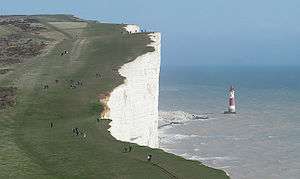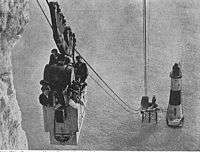Beachy Head Lighthouse
Beachy Head Lighthouse is a lighthouse located in the English Channel below Beachy Head in East Sussex. It is 43 m (141 ft) in height and became operational in October 1902.[3] It was the last traditional-style 'rock tower' (i.e. offshore lighthouse) to be built by Trinity House.[4]
 | |
 East Sussex | |
| Location | Eastbourne East Sussex England |
|---|---|
| Coordinates | 50°44′02″N 0°14′29″E |
| Year first constructed | 1802 |
| Automated | 1983 |
| Foundation | concrete base |
| Construction | granite tower |
| Tower shape | tapered cylindrical with balcony and lantern |
| Markings / pattern | white tower with a broad horizontal red band, red lantern |
| Tower height | 43 m (141 ft) |
| Focal height | 31 m (102 ft) |
| Original lens | First Order 920 mm Asymmetrical Catadioptric rotating optic |
| Current lens | Single-tier LED lantern |
| Range | 8 nmi (15 km; 9.2 mi)[1] |
| Characteristic | Fl (2) W 20s. |
| Fog signal | blast every 30s. (Discontinued 2011) |
| Admiralty number | A0840 |
| NGA number | 1140 |
| ARLHS number | ENG 005 |
| Managing agent | Trinity House[2] |
| Heritage | Grade II listed building |
Construction
In 1900 to 1902 under the direction of Sir Thomas Matthews, the Trinity House Engineer-in-Chief, the lighthouse was built, sited about 165 metres seawards from the base of the cliffs. For the construction, a temporary cable car from the cliff was installed for the transport of workers and stones to an iron ocean platform adjacent to the lighthouse. 3,660 tons of Cornish granite were used in the construction of the tower.
The lighthouse was equipped with a first-order revolving catadioptric optic made up of three double panels, giving two white flashes every 20 seconds;[5] The lightsource was a Matthews-designed paraffin vapour burner. The newly-built lighthouse was also provided with an explosive fog signal, which was sounded every five minutes in foggy weather; it involved the keepers attaching a small explosive charge together with a detonator to each arm of a jib located on the gallery of the lighthouse; when winched into place, connection was made with a dynamo-electric firing machine inside the lantern, from where the charge was remotely fired.[5]
Operation
For more than 80 years, the red-and-white striped tower was manned by three lighthouse keepers. Their primary job was to maintain the revolving light, which was then visible 26 nautical miles (48 km; 30 mi) out to sea. For most of the 20th century cooking was done on a solid-fuel range and the accommodation was lit by paraffin lamps.[4] Electricity first reached the lighthouse in 1975, whereupon an electric lamp was installed in the optic. The explosive fog signal remained in use until 1976 (when it was replaced by an 'ELG 500' electric emitter); at the time Beachy Head was one of the last lighthouses still using explosive signals.[5] The lighthouse was fully automated in 1983 and the keepers withdrawn.
A chalk fall on the cliff in 1999 severed the electric cable; during its repair the lamp and fog signal were replaced and upgraded.[4] In June 2010, Trinity House announced in the five yearly "Aids To Navigation Review" that the light range would be reduced to 8 nmi (15 km; 9.2 mi) and the fog signal discontinued. In February 2011, the work was undertaken and light range reduced by the installation of a new LED navigation light system. The old lens, though no longer in use, was left in situ. The fog signal was also discontinued at this time.
Trinity House announced in 2011 that it could no longer afford to repaint the distinctive red and white stripes and that it would have to be left to return to its natural granite grey. It stated that because boats now have high tech navigational systems the day marker stripes are no longer essential. However, a sponsored campaign to keep the stripes was launched in October 2011. The required £27,000 was raised.[6] The tower repainting was completed in October using a team including two abseilers. Five coats of paint were applied to the copper lantern at the top and three on each hoop of the tower.[7]
In 2019 with the impending demolition of the Royal Sovereign Lighthouse, Trinity House has said it will increase the strength of Beachy Heads light to compensate for the loss of Royal Sovereign.[8]
Gallery
 Looking towards the cliffs and lighthouse from the west near Birling Gap
Looking towards the cliffs and lighthouse from the west near Birling Gap Temporary cable car for the construction of the lighthouse
Temporary cable car for the construction of the lighthouse The lighthouse from the sea
The lighthouse from the sea The lighthouse from the east side
The lighthouse from the east side.jpg) Detail of the lighthouse
Detail of the lighthouse
In popular culture
The lighthouse was a setting in an episode of The Prisoner called The Girl Who Was Death.
References
- List of Lights, Pub. 114: British Isles, English Channel and North Sea (PDF). List of Lights. United States National Geospatial-Intelligence Agency. 2015.
- Beachy Head The Lighthouse Directory. University of North Carolina at Chapel Hill. Retrieved 29 April 2016
- Surtees, Dr John (1997). Beachy Head. Seaford: SB Publications. ISBN 1-85770-118-6.
- Woodman, Richard; Wilson, Jane (2002). The Lighthouses of Trinity House. Bradford-on-Avon, Wilts.: Thomas Reed. pp. 96–97.
- Renton, Alan (2001). Lost Sounds: The Story of Coast Fog Signals. Caithness, Scotland: Whittles.
- "Beachy Head Lighthouse Campaign". Beachy Head Lighthouse Campaign.
- "Beachy Head lighthouse repainting 'finishing touches'". BBC.
- Lighthouse webmaster - Geoffrey Baker - info@lhdigest.com. "Lighthouses@Lighthouse Digest ... Royal Sovereign Light To Be Demolished". www.lighthousedigest.com. Retrieved 17 February 2020.